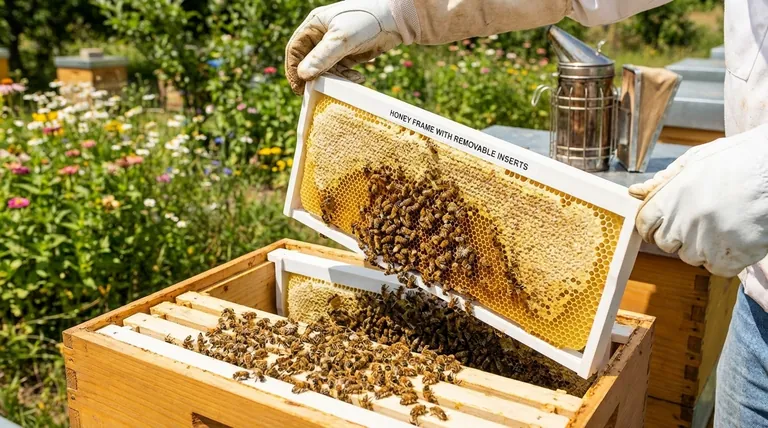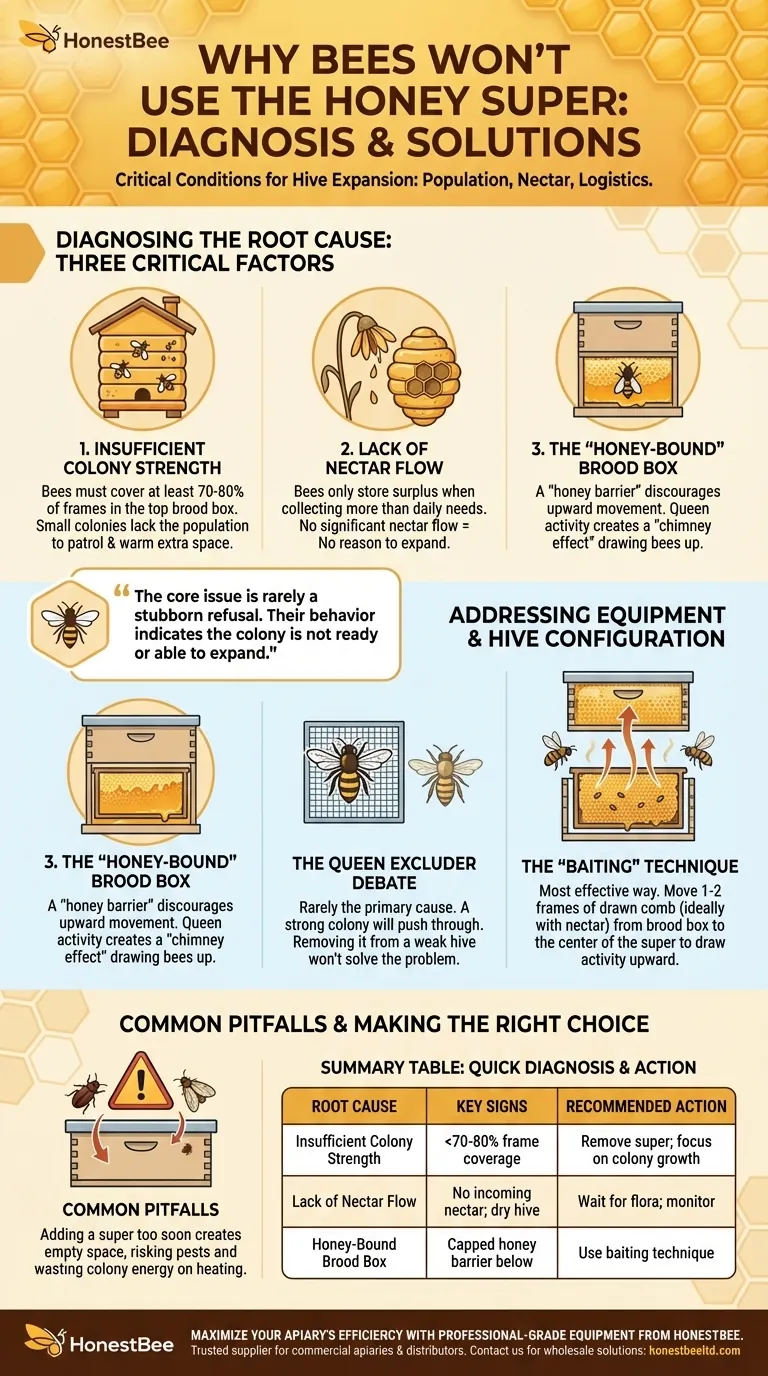When bees refuse to move into a honey super, it is almost always a signal that one of three critical conditions has not been met. The problem is typically not the equipment itself but rather insufficient colony strength, a lack of incoming nectar, or a poorly configured hive that discourages upward expansion. Addressing these root causes is the key to encouraging the bees to begin storing honey.
The core issue is rarely a stubborn refusal by the bees. Instead, their behavior indicates that the colony is not yet ready or able to expand. Your role is to diagnose whether the problem is population size, food availability, or internal hive logistics.

Diagnosing the Root Cause: Three Critical Factors
Before making any changes, a thorough inspection is necessary to understand why the bees are not using the super. The answer lies within the brood box below.
Factor 1: Insufficient Colony Strength
A honey super represents a large, new space that the colony must patrol, defend, and keep warm. A small or developing colony simply lacks the population to manage this extra territory.
To be ready for a super, a strong hive should have bees covering at least 70-80% of the frames in the top brood box. If you open the hive and see only a few frames covered with bees, the colony is not yet strong enough.
Factor 2: Lack of a Nectar Flow
Bees only store surplus honey when they are collecting more nectar than they need for their immediate daily operations. If there is no significant nectar flow, they have no reason to expand into a super.
Check for a nectar flow by observing the hive entrance for heavy pollen and nectar traffic. Inside the hive, look for cells containing fresh, watery nectar that hasn't been capped yet. If the hive is dry, there's no flow.
Factor 3: The "Honey-Bound" Brood Box
Bees are reluctant to cross empty space. If the frames directly below the new honey super are not being used or are filled with capped honey (a "honey barrier"), the bees see no reason to move upward.
Ideally, the queen should be actively laying eggs in the top brood box. This activity creates a "chimney effect," drawing worker bees upward to support the brood and, eventually, into the super above.
Addressing Equipment and Hive Configuration
Once you have confirmed the colony is strong and a nectar flow is on, you can look at equipment issues that may be hindering their progress.
The Queen Excluder Debate
A queen excluder is often blamed when bees won't enter a super. While it can act as a barrier, a strong, motivated colony will push through it without hesitation.
The excluder is rarely the primary cause if the colony is weak or there's no nectar flow. Removing it from a weak hive will not solve the underlying problem.
The "Baiting" Technique
The most effective way to encourage bees to move up is to give them a familiar reason to do so. This is known as "baiting" the super.
Carefully pull one or two frames of drawn comb (ideally with some nectar, but not open brood) from the outside edges of the brood box. Place these frames in the center of the new honey super, and move two new, undrawn frames from the super down into their place in the brood box. This draws the scent and activity upward.
Common Pitfalls to Avoid
Impatience can lead to decisions that harm the colony more than help it. Understanding the risks is critical for successful hive management.
The Risk of Adding a Super Too Soon
Adding a honey super before the colony is ready creates a large, empty void. This space can become a breeding ground for pests like small hive beetles and wax moths, which a small colony cannot effectively defend.
It also forces the bees to expend energy trying to patrol and heat a space they cannot use, potentially slowing the colony's overall development.
The Mistake of Blaming the Bees
It is essential to view an unused super not as a failure, but as a piece of data from the hive. The bees are communicating that a necessary condition for expansion is missing.
Forcing the issue by adding attractants or making drastic changes without a proper diagnosis rarely works. The goal is to facilitate the bees' natural instincts, not fight against them.
Making the Right Choice for Your Goal
Based on your hive inspection, take the appropriate corrective action.
- If your primary focus is building a weak colony: Remove the honey super entirely. Let the bees focus their resources on filling out the brood box.
- If your primary focus is waiting for nectar: Leave the hive as is and be patient. Monitor local flora and weather; the bees will move up when the flow begins.
- If your primary focus is encouraging a strong, honey-bound colony: Use the "baiting" technique by moving a frame of drawn comb up into the center of the super.
- If your primary focus is a strong colony that still won't cross the excluder: As a last resort, you can temporarily remove the queen excluder. Once the bees start drawing comb in the super, you can place it back to ensure the queen doesn't lay eggs there.
By correctly reading the signals from your colony, you can work with its natural rhythms to ensure a productive and healthy hive.
Summary Table:
| Root Cause | Key Signs | Recommended Action |
|---|---|---|
| Insufficient Colony Strength | Less than 70-80% frame coverage in brood box | Remove super; focus on colony growth |
| Lack of Nectar Flow | No incoming nectar; dry hive frames | Wait for local flora to bloom |
| Honey-Bound Brood Box | Capped honey barrier below super | Use baiting technique with drawn comb |
Maximize your apiary's efficiency with professional-grade equipment from HONESTBEE.
As a trusted supplier for commercial apiaries and beekeeping equipment distributors, we provide wholesale solutions designed to support strong, productive hives. Let our expertise help you overcome common beekeeping challenges and achieve higher honey yields.
Contact HONESTBEE today to discuss your commercial beekeeping equipment needs!
Visual Guide

Related Products
- Professional 500g Sectional Comb Honey Frame System for Beekeeping
- Langstroth Honey Bee Box Hive Boxes for Different Depths
- Professional Insulated Plastic Bee Hives
- Inverted Squeezable Honey Jar with No Drip Flip Top Cap for Easy Pouring
- Automatic Heat Preservation 6 Frame Pro Nuc Box for Honey Bee Queen Mating
People Also Ask
- How much honey can you get from one frame? Maximize Your Harvest with the Right Frame Size
- What is a benefit of storing honey-laden frames? A Strategic Food Source for Spring Colony Survival
- What frame to use for honeycomb? Choose the Right System for Pure, Edible Comb
- How do you inspect honey frames? Master the 70-80% Rule for Healthy Hives
- How do bees use Flow Frames? A Guide to Stress-Free Honey Harvesting



















